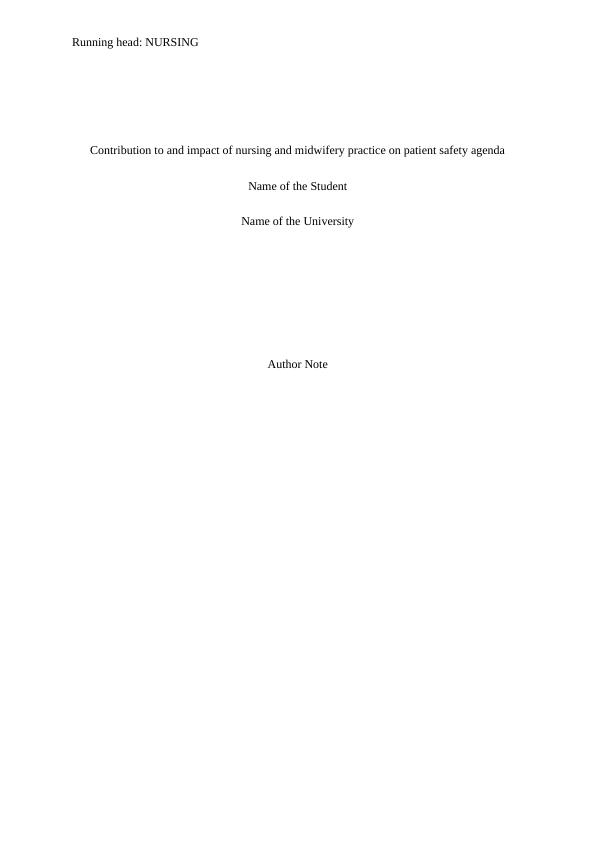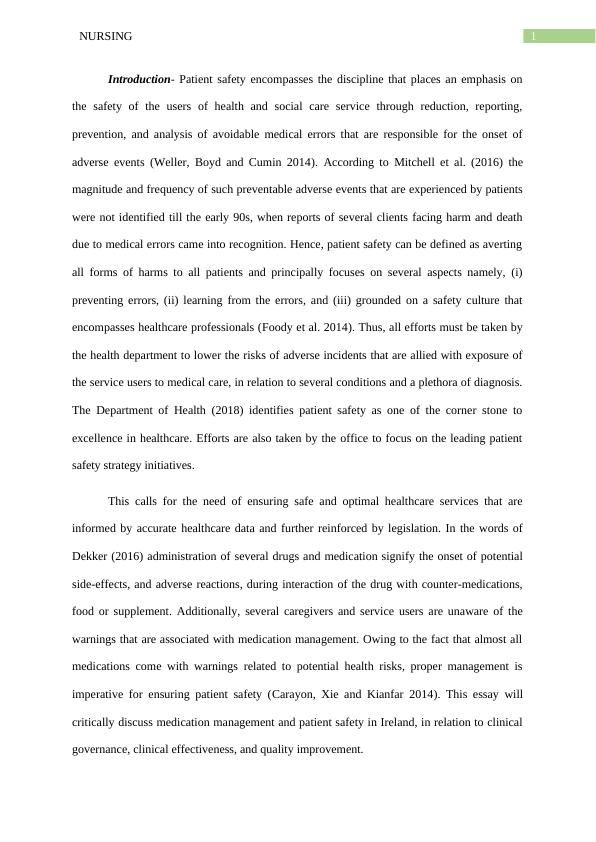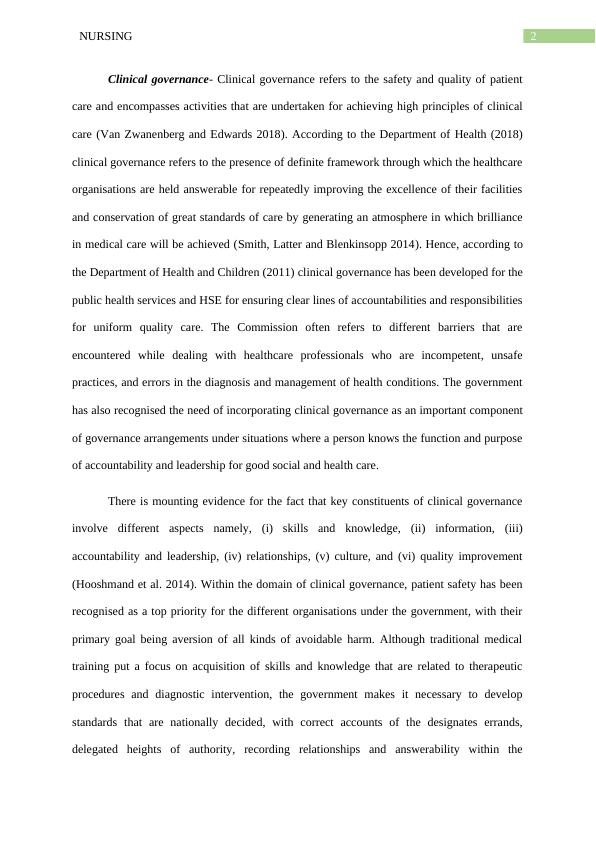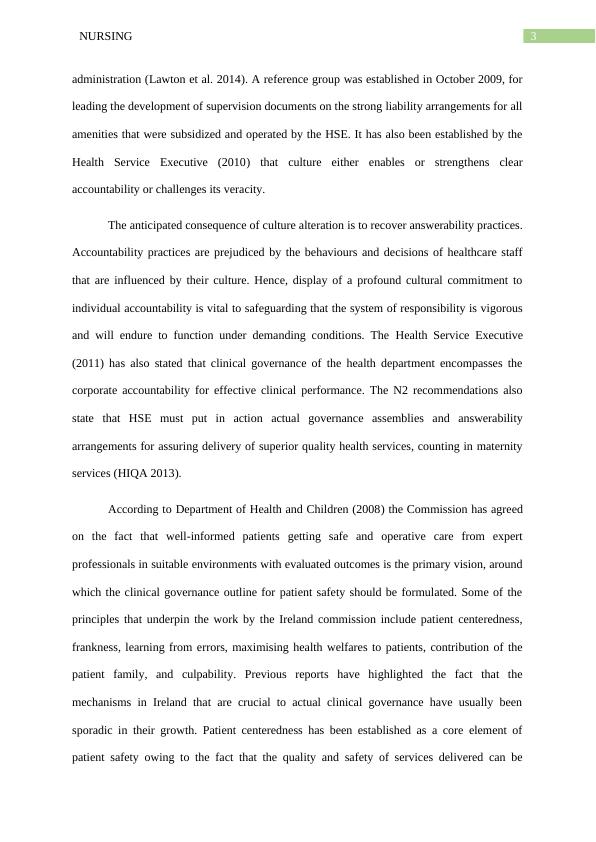Contribution to and Impact of Nursing and Midwifery Practice on Patient Safety Agenda
Added on 2023-04-21
18 Pages5547 Words281 Views
Running head: NURSING
Contribution to and impact of nursing and midwifery practice on patient safety agenda
Name of the Student
Name of the University
Author Note
Contribution to and impact of nursing and midwifery practice on patient safety agenda
Name of the Student
Name of the University
Author Note

1NURSING
Introduction- Patient safety encompasses the discipline that places an emphasis on
the safety of the users of health and social care service through reduction, reporting,
prevention, and analysis of avoidable medical errors that are responsible for the onset of
adverse events (Weller, Boyd and Cumin 2014). According to Mitchell et al. (2016) the
magnitude and frequency of such preventable adverse events that are experienced by patients
were not identified till the early 90s, when reports of several clients facing harm and death
due to medical errors came into recognition. Hence, patient safety can be defined as averting
all forms of harms to all patients and principally focuses on several aspects namely, (i)
preventing errors, (ii) learning from the errors, and (iii) grounded on a safety culture that
encompasses healthcare professionals (Foody et al. 2014). Thus, all efforts must be taken by
the health department to lower the risks of adverse incidents that are allied with exposure of
the service users to medical care, in relation to several conditions and a plethora of diagnosis.
The Department of Health (2018) identifies patient safety as one of the corner stone to
excellence in healthcare. Efforts are also taken by the office to focus on the leading patient
safety strategy initiatives.
This calls for the need of ensuring safe and optimal healthcare services that are
informed by accurate healthcare data and further reinforced by legislation. In the words of
Dekker (2016) administration of several drugs and medication signify the onset of potential
side-effects, and adverse reactions, during interaction of the drug with counter-medications,
food or supplement. Additionally, several caregivers and service users are unaware of the
warnings that are associated with medication management. Owing to the fact that almost all
medications come with warnings related to potential health risks, proper management is
imperative for ensuring patient safety (Carayon, Xie and Kianfar 2014). This essay will
critically discuss medication management and patient safety in Ireland, in relation to clinical
governance, clinical effectiveness, and quality improvement.
Introduction- Patient safety encompasses the discipline that places an emphasis on
the safety of the users of health and social care service through reduction, reporting,
prevention, and analysis of avoidable medical errors that are responsible for the onset of
adverse events (Weller, Boyd and Cumin 2014). According to Mitchell et al. (2016) the
magnitude and frequency of such preventable adverse events that are experienced by patients
were not identified till the early 90s, when reports of several clients facing harm and death
due to medical errors came into recognition. Hence, patient safety can be defined as averting
all forms of harms to all patients and principally focuses on several aspects namely, (i)
preventing errors, (ii) learning from the errors, and (iii) grounded on a safety culture that
encompasses healthcare professionals (Foody et al. 2014). Thus, all efforts must be taken by
the health department to lower the risks of adverse incidents that are allied with exposure of
the service users to medical care, in relation to several conditions and a plethora of diagnosis.
The Department of Health (2018) identifies patient safety as one of the corner stone to
excellence in healthcare. Efforts are also taken by the office to focus on the leading patient
safety strategy initiatives.
This calls for the need of ensuring safe and optimal healthcare services that are
informed by accurate healthcare data and further reinforced by legislation. In the words of
Dekker (2016) administration of several drugs and medication signify the onset of potential
side-effects, and adverse reactions, during interaction of the drug with counter-medications,
food or supplement. Additionally, several caregivers and service users are unaware of the
warnings that are associated with medication management. Owing to the fact that almost all
medications come with warnings related to potential health risks, proper management is
imperative for ensuring patient safety (Carayon, Xie and Kianfar 2014). This essay will
critically discuss medication management and patient safety in Ireland, in relation to clinical
governance, clinical effectiveness, and quality improvement.

2NURSING
Clinical governance- Clinical governance refers to the safety and quality of patient
care and encompasses activities that are undertaken for achieving high principles of clinical
care (Van Zwanenberg and Edwards 2018). According to the Department of Health (2018)
clinical governance refers to the presence of definite framework through which the healthcare
organisations are held answerable for repeatedly improving the excellence of their facilities
and conservation of great standards of care by generating an atmosphere in which brilliance
in medical care will be achieved (Smith, Latter and Blenkinsopp 2014). Hence, according to
the Department of Health and Children (2011) clinical governance has been developed for the
public health services and HSE for ensuring clear lines of accountabilities and responsibilities
for uniform quality care. The Commission often refers to different barriers that are
encountered while dealing with healthcare professionals who are incompetent, unsafe
practices, and errors in the diagnosis and management of health conditions. The government
has also recognised the need of incorporating clinical governance as an important component
of governance arrangements under situations where a person knows the function and purpose
of accountability and leadership for good social and health care.
There is mounting evidence for the fact that key constituents of clinical governance
involve different aspects namely, (i) skills and knowledge, (ii) information, (iii)
accountability and leadership, (iv) relationships, (v) culture, and (vi) quality improvement
(Hooshmand et al. 2014). Within the domain of clinical governance, patient safety has been
recognised as a top priority for the different organisations under the government, with their
primary goal being aversion of all kinds of avoidable harm. Although traditional medical
training put a focus on acquisition of skills and knowledge that are related to therapeutic
procedures and diagnostic intervention, the government makes it necessary to develop
standards that are nationally decided, with correct accounts of the designates errands,
delegated heights of authority, recording relationships and answerability within the
Clinical governance- Clinical governance refers to the safety and quality of patient
care and encompasses activities that are undertaken for achieving high principles of clinical
care (Van Zwanenberg and Edwards 2018). According to the Department of Health (2018)
clinical governance refers to the presence of definite framework through which the healthcare
organisations are held answerable for repeatedly improving the excellence of their facilities
and conservation of great standards of care by generating an atmosphere in which brilliance
in medical care will be achieved (Smith, Latter and Blenkinsopp 2014). Hence, according to
the Department of Health and Children (2011) clinical governance has been developed for the
public health services and HSE for ensuring clear lines of accountabilities and responsibilities
for uniform quality care. The Commission often refers to different barriers that are
encountered while dealing with healthcare professionals who are incompetent, unsafe
practices, and errors in the diagnosis and management of health conditions. The government
has also recognised the need of incorporating clinical governance as an important component
of governance arrangements under situations where a person knows the function and purpose
of accountability and leadership for good social and health care.
There is mounting evidence for the fact that key constituents of clinical governance
involve different aspects namely, (i) skills and knowledge, (ii) information, (iii)
accountability and leadership, (iv) relationships, (v) culture, and (vi) quality improvement
(Hooshmand et al. 2014). Within the domain of clinical governance, patient safety has been
recognised as a top priority for the different organisations under the government, with their
primary goal being aversion of all kinds of avoidable harm. Although traditional medical
training put a focus on acquisition of skills and knowledge that are related to therapeutic
procedures and diagnostic intervention, the government makes it necessary to develop
standards that are nationally decided, with correct accounts of the designates errands,
delegated heights of authority, recording relationships and answerability within the

3NURSING
administration (Lawton et al. 2014). A reference group was established in October 2009, for
leading the development of supervision documents on the strong liability arrangements for all
amenities that were subsidized and operated by the HSE. It has also been established by the
Health Service Executive (2010) that culture either enables or strengthens clear
accountability or challenges its veracity.
The anticipated consequence of culture alteration is to recover answerability practices.
Accountability practices are prejudiced by the behaviours and decisions of healthcare staff
that are influenced by their culture. Hence, display of a profound cultural commitment to
individual accountability is vital to safeguarding that the system of responsibility is vigorous
and will endure to function under demanding conditions. The Health Service Executive
(2011) has also stated that clinical governance of the health department encompasses the
corporate accountability for effective clinical performance. The N2 recommendations also
state that HSE must put in action actual governance assemblies and answerability
arrangements for assuring delivery of superior quality health services, counting in maternity
services (HIQA 2013).
According to Department of Health and Children (2008) the Commission has agreed
on the fact that well-informed patients getting safe and operative care from expert
professionals in suitable environments with evaluated outcomes is the primary vision, around
which the clinical governance outline for patient safety should be formulated. Some of the
principles that underpin the work by the Ireland commission include patient centeredness,
frankness, learning from errors, maximising health welfares to patients, contribution of the
patient family, and culpability. Previous reports have highlighted the fact that the
mechanisms in Ireland that are crucial to actual clinical governance have usually been
sporadic in their growth. Patient centeredness has been established as a core element of
patient safety owing to the fact that the quality and safety of services delivered can be
administration (Lawton et al. 2014). A reference group was established in October 2009, for
leading the development of supervision documents on the strong liability arrangements for all
amenities that were subsidized and operated by the HSE. It has also been established by the
Health Service Executive (2010) that culture either enables or strengthens clear
accountability or challenges its veracity.
The anticipated consequence of culture alteration is to recover answerability practices.
Accountability practices are prejudiced by the behaviours and decisions of healthcare staff
that are influenced by their culture. Hence, display of a profound cultural commitment to
individual accountability is vital to safeguarding that the system of responsibility is vigorous
and will endure to function under demanding conditions. The Health Service Executive
(2011) has also stated that clinical governance of the health department encompasses the
corporate accountability for effective clinical performance. The N2 recommendations also
state that HSE must put in action actual governance assemblies and answerability
arrangements for assuring delivery of superior quality health services, counting in maternity
services (HIQA 2013).
According to Department of Health and Children (2008) the Commission has agreed
on the fact that well-informed patients getting safe and operative care from expert
professionals in suitable environments with evaluated outcomes is the primary vision, around
which the clinical governance outline for patient safety should be formulated. Some of the
principles that underpin the work by the Ireland commission include patient centeredness,
frankness, learning from errors, maximising health welfares to patients, contribution of the
patient family, and culpability. Previous reports have highlighted the fact that the
mechanisms in Ireland that are crucial to actual clinical governance have usually been
sporadic in their growth. Patient centeredness has been established as a core element of
patient safety owing to the fact that the quality and safety of services delivered can be

End of preview
Want to access all the pages? Upload your documents or become a member.
Related Documents
Medication Safety: Strategies to Minimize Medication Errorslg...
|6
|1509
|89
APINCH Drugs and Its Adverse Effectslg...
|8
|1595
|92
The Role of Nursing Informatics in Ensuring Patient Safety: A Discussionlg...
|3
|467
|377
Reducing Medication Errors in Acute Wards through CPOE Training for Nurseslg...
|13
|5351
|360
Safety Using in Nursing Research 2022lg...
|7
|1594
|13
Nursing Leadership in Australia: Assignmentlg...
|21
|6732
|51